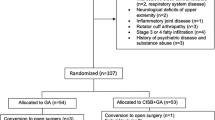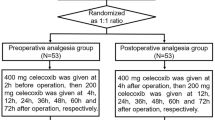Abstract
Purpose
The aim of the study reported here was to compare the efficacy and safety of postoperative analgesia provided by interscalene block with multimodal pain control (IB-MPC) versus that provided by multimodal pain control (MPC) alone after arthroscopic rotator cuff repair.
Methods
Sixty consecutive patients were assigned to either the IB-MPC group (30 patients) or the MPC group (30 patients). Visual analogue scale (VAS) pain scores before surgery and through day 5 after surgery, consumption of rescue analgesic, adverse effects and complications were evaluated.
Results
Mean VAS pain scores immediately after surgery and on days 1 through 5 after surgery were 3.9 ± 2.6, 4.4 ± 1.5, 3.4 ± 1.3, 2.7 ± 1.3, 2.4 ± 1.2, and 2.0 ± 1.0, respectively, in the IB-MPC group and 6.2 ± 1.8, 4.1 ± 1.7, 3.2 ± 1.9, 2.7 ± 1.4, 2.5 ± 1.3, and 2.0 ± 1.2, respectively, in the MPC group. The IB-MPC group had significantly lower VAS pain score immediately after surgery than the MPC group did (P < 0.001). There were no statistically significant differences regarding consumption of rescue analgesic or adverse effects between the two groups (n.s.). In the IB-MPC group, complications related to interscalene block included tingling of the hand in three patients and numbness of the neck and ear in two. However, these symptoms resolved spontaneously within a few days. No patients had major complications related to interscalene block.
Conclusions
IB-MPC achieved better pain control immediately after surgery than MPC alone, without major complications related to interscalene block. It is an effective and safe method for providing postoperative analgesia after arthroscopic rotator cuff repair.
Level of evidence
Prospective Comparative Study, Prognosis Study, Level II.

Similar content being viewed by others
References
Bishop JY, Sprague M, Gelber J, Krol M, Rosenblatt MA, Gladstone J, Flatow EL (2005) Interscalene regional anesthesia for shoulder surgery. J Bone Joint Surg Am 87:974–979
Boss AP, Maurer T, Seiler S, Aeschbach A, Hintermann B, Strebel S (2004) Continuous subacromial bupivacaine infusion for postoperative analgesia after open acromioplasty and rotator cuff repair: preliminary results. J Shoulder Elbow Surg 13:630–634
Brown AR, Weiss R, Greenberg C, Flatow EL, Bigliani LU (1993) Interscalene block for shoulder arthroscopy: comparison with general anesthesia. Arthroscopy 9:295–300
Chao D, Young S, Cawley P (2006) Postoperative pain management for arthroscopic shoulder surgery: interscalene block versus patient-controlled infusion of 0.25% bupivicaine. Am J Orthop (Belle Mead NJ) 35:231–234
Cho CH, Song KS, Min BW, Lee KJ, Ha E, Lee YC, Lee YK (2011) Multimodal approach to postoperative pain control in patients undergoing rotator cuff repair. Knee Surg Sports Traumatol Arthrosc 19:1744–1748
Cho NS, Ha JH, Rhee YG (2007) Patient-controlled analgesia after arthroscopic rotator cuff repair: subacromial catheter versus intravenous injection. Am J Sports Med 35:75–79
Chung F, Ritchie E, Su J (1997) Postoperative pain in ambulatory surgery. Anesth Analg 85:808–816
Ciccone WJ 2nd, Busey TD, Weinstein DM, Walden DL, Elias JJ (2008) Assessment of pain relief provided by interscalene regional block and infusion pump after arthroscopic shoulder surgery. Arthroscopy 24:14–19
Conroy BP, Gray BC, Fischer RB, Del Campo LJ, Kenter K (2003) Interscalene block for elective shoulder surgery. Orthopedics 26:501–503
Dorr LD, Raya J, Long WT, Boutary M, Sirianni LE (2008) Multimodal analgesia without parenteral narcotics for total knee arthroplasty. J Arthroplasty 23:502–508
Edde RR, Deutsch S (1977) Cardiac arrest after interscalene brachial-plexus block. Anesth Analg 56:446–447
Elvir-Lazo OL, White PF (2010) Postoperative pain management after ambulatory surgery: role of multimodal analgesia. Anesthesiol Clin 28:217–224
Fredrickson MJ, Krishnan S, Chen CY (2010) Postoperative analgesia for shoulder surgery: a critical appraisal and review of current techniques. Anaesthesia 65:608–624
Goebel S, Stehle J, Schwemmer U, Reppenhagen S, Rath B, Gohlke F (2010) Interscalene brachial plexus block for open-shoulder surgery: a randomized, double-blind, placebo-controlled trial between single-shot anesthesia and patient-controlled catheter system. Arch Orthop Trauma Surg 130:533–540
Hartrick CT, Tang YS, Siwek D, Murray R, Hunstad D, Smith G (2012) The effect of initial local anesthetic dose with continuous interscalene analgesia on postoperative pain and diaphragmatic function in patients undergoing arthroscopic shoulder surgery: a double-blind, randomized controlled trial. BMC Anesthesiol 12:6
Hofmann-Kiefer K, Eiser T, Chappell D, Leuschner S, Conzen P, Schwender D (2008) Does patient-controlled continuous interscalene block improve early functional rehabilitation after open shoulder surgery? Anesth Analg 106:991–996
Kayerker UM, Dick MM (1983) Phrenic nerve paralysis following interscalene brachial plexus block. Anesth Analg 62:536–537
Kumar A, Battit GE, Froese AB, Long MC (1971) Bilateral cervical and thoracic epidural blockade complicating interscalene brachial plexus block: report of two cases. Anesthesiology 35:650–652
Lee SM, Park SE, Nam YS et al (2012) Analgesic effectiveness of nerve block in shoulder arthroscopy: comparison between interscalene, suprascapular and axillary nerve blocks. Knee Surg Sports Traumatol Arthrosc. doi:10.1007/s00167-012-1950-5
Misamore G, Webb B, McMurray S, Sallay P (2011) A prospective analysis of interscalene brachial plexus blocks performed under general anesthesia. J Shoulder Elbow Surg 20:308–314
Oh JH, Kim WS, Kim JY, Gong HS, Rhee KY (2007) Continuous intralesional infusion combined with interscalene block was effective for postoperative analgesia after arthroscopic shoulder surgery. J Shoulder Elbow Surg 16:295–299
Oh JH, Rhee KY, Kim SH, Lee PB, Lee JW, Lee SJ (2009) Comparison of analgesic efficacy between single interscalene block combined with a continuous intra-bursal infusion of ropivacaine and continuous interscalene block after arthroscopic rotator cuff repair. Clin Orthop Surg 1:48–53
Ruiz-Suarez M, Barber FA (2008) Postoperative pain control after shoulder arthroscopy. Orthopedics 31:1130
Scoggin JF 3rd, Mayfield G, Awaya DJ, Pi M, Prentiss J, Takahashi J (2002) Subacromial and intra-articular morphine versus bupivacaine after shoulder arthroscopy. Arthroscopy 18:464–468
Seltzer JL (1977) Hoarseness and Horner’s syndrome after interscalene brachial plexus block. Anesth Analg 56:585–586
Singelyn FJ, Lhotel L, Fabre B (2004) Pain relief after arthroscopic shoulder surgery: a comparison of intraarticular analgesia, suprascapular nerve block, and interscalene brachial plexus block. Anesth Analg 99:589–592
Skinner HB (2004) Multimodal acute pain management. Am J Orthop (Belle Mead NJ) 33:5–9
Viscusi ER (2004) Emerging techniques for postoperative analgesia in orthopedic surgery. Am J Orthop (Belle Mead NJ) 33:13–16
Webb D, Guttmann D, Cawley P, Lubowitz JH (2007) Continuous infusion of a local anesthetic versus interscalene block for postoperative pain control after arthroscopic shoulder surgery. Arthroscopy 23:1006–1011
Author information
Authors and Affiliations
Corresponding author
Rights and permissions
About this article
Cite this article
Cho, CH., Song, KS., Min, BW. et al. Efficacy of interscalene block combined with multimodal pain control for postoperative analgesia after rotator cuff repair. Knee Surg Sports Traumatol Arthrosc 23, 542–547 (2015). https://doi.org/10.1007/s00167-012-2272-3
Received:
Accepted:
Published:
Issue Date:
DOI: https://doi.org/10.1007/s00167-012-2272-3




